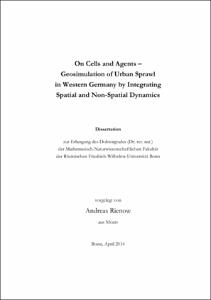On Cells and AgentsGeosimulation of Urban Sprawl in Western Germany by Integrating Spatial and Non-Spatial Dynamics

On Cells and Agents
Geosimulation of Urban Sprawl in Western Germany by Integrating Spatial and Non-Spatial Dynamics

| dc.contributor.advisor | Menz, Gunter | |
| dc.contributor.author | Rienow, Andreas | |
| dc.date.accessioned | 2020-04-19T23:44:57Z | |
| dc.date.available | 2020-04-19T23:44:57Z | |
| dc.date.issued | 18.07.2014 | |
| dc.identifier.uri | https://hdl.handle.net/20.500.11811/6122 | |
| dc.description.abstract | Urban sprawl is one of the most challenging land-use and land-cover changes in Germany implicating numerous consequences for the anthropogenic and geobiophysical spheres. While the population and job growth rates of most urban areas stagnate or even decrease, the morphological growth of cities is ubiquitous. Against this backdrop, the quantitative and qualitative modeling of urban dynamics proves to be of central importance. Geosimulation models like cellular automata (CA) and multi-agent systems (MAS) treat cities as complex urban systems. While CA focus on their spatial dynamics, MAS are well-suited for capturing autonomous individual decision making. Yet both models are complementary in terms of their focus, status change, mobility, and representations. Hence, the coupling of CA and MAS is a useful way of integrating spatial pattern and non-spatial processes into one modeling infrastructure. The thesis at hand aims at a holistic geosimulation of the future urban sprawl in the Ruhr. This region is particularly challenging as it is characterized by two seemingly antagonistic processes: urban growth and urban shrinkage. Accordingly, a hybrid modeling approach is to be developed as a means of integrating the simulation power of CA and MAS. A modified version of SLEUTH (short for Slope, Land-use, Exclusion, Urban, Transport, and Hillshade) will function as the CA component. SLEUTH makes use of historic urban land-use data sets and growth coefficients for the purpose of modeling physical urban expansion. In order to enhance the simulation performance of the CA and to incorporate important driving forces of urban sprawl, SLEUTH is for the first time combined with support vector machines (SVM). The supported CA will be coupled with ReHoSh (Residential Mobility and the Housing Market of Shrinking City Systems). This MAS models population patterns, housing prices, and housing demand in shrinking regions. All dynamics are based on multiple interactions between different household groups as well as stakeholders of the housing market. Moreover, this thesis will elaborate on the most important driving factors, rates, and most probable locations of urban sprawl in the Ruhr as well as on the future migration tendencies of different household types and the price development in the housing market of a polycentric shrinking region. The results of SLEUTH and ReHoSh are loosely coupled for a spatial analysis in which the municipal differences that have emerged during the simulations are disaggregated. Subsequently, a concept is developed in order to integrate the CA and the MAS into one geosimulation approach. The thesis introduces semi-explicit urban weights as a possibility of assessing settlement-pattern dynamics and the regional housing market dynamics at the same time. The model combination of SLEUTH-SVM and ReHoSh is finally calibrated, validated, and implemented for simulating three different scenarios of individual housing preferences and their effects on the future urban pattern in the Ruhr. Applied to a digital petri dish, the generic urban growth elements of the Ruhr are being detected. | en |
| dc.language.iso | eng | |
| dc.rights | In Copyright | |
| dc.rights.uri | http://rightsstatements.org/vocab/InC/1.0/ | |
| dc.subject | Zelluläre Automaten | |
| dc.subject | Stützvektormaschine | |
| dc.subject | Agentenbasierte Modelle | |
| dc.subject | Suburbanisierung | |
| dc.subject | Siedlungsschrumpfung | |
| dc.subject | Cellular Automata | |
| dc.subject | Multi-Agent Systems | |
| dc.subject | Support Vector Machines | |
| dc.subject | Urban Sprawl | |
| dc.subject | Urban Shrinkage | |
| dc.subject.ddc | 550 Geowissenschaften | |
| dc.title | On Cells and Agents | |
| dc.title.alternative | Geosimulation of Urban Sprawl in Western Germany by Integrating Spatial and Non-Spatial Dynamics | |
| dc.type | Dissertation oder Habilitation | |
| dc.publisher.name | Universitäts- und Landesbibliothek Bonn | |
| dc.publisher.location | Bonn | |
| dc.rights.accessRights | openAccess | |
| dc.identifier.urn | https://nbn-resolving.org/urn:nbn:de:hbz:5n-36681 | |
| ulbbn.pubtype | Erstveröffentlichung | |
| ulbbnediss.affiliation.name | Rheinische Friedrich-Wilhelms-Universität Bonn | |
| ulbbnediss.affiliation.location | Bonn | |
| ulbbnediss.thesis.level | Dissertation | |
| ulbbnediss.dissID | 3668 | |
| ulbbnediss.date.accepted | 01.07.2014 | |
| ulbbnediss.institute | Mathematisch-Naturwissenschaftliche Fakultät : Fachgruppe Erdwissenschaften / Geographisches Institut | |
| ulbbnediss.fakultaet | Mathematisch-Naturwissenschaftliche Fakultät | |
| dc.contributor.coReferee | Greve, Klaus |
Dateien zu dieser Ressource
Das Dokument erscheint in:
-
E-Dissertationen (4387)




